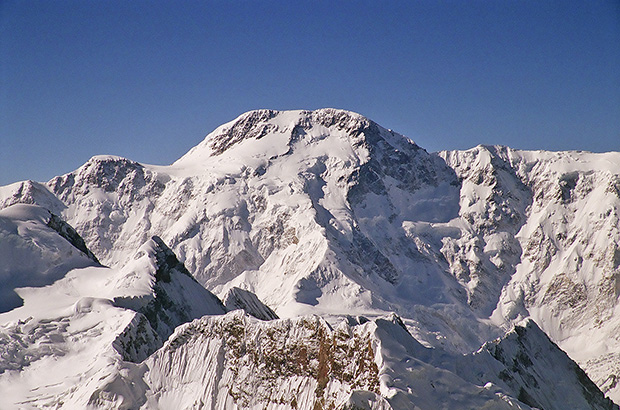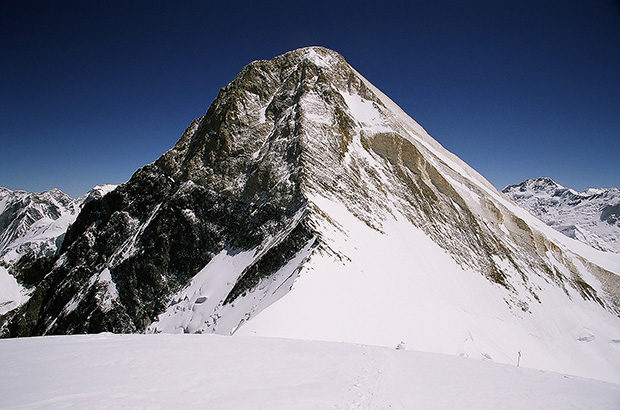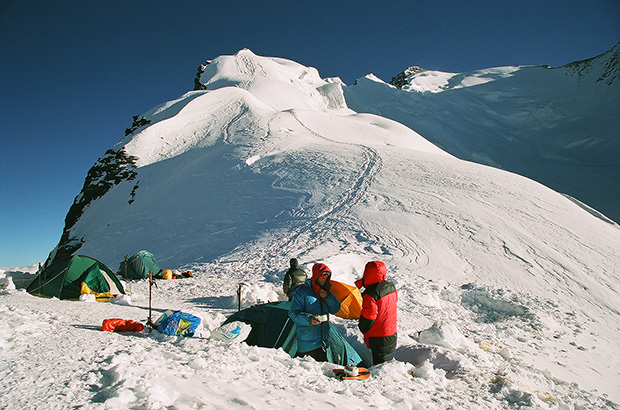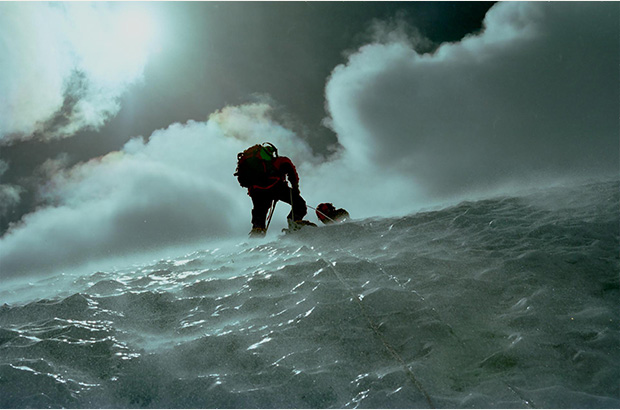FAQ
- Bolivia climbing questions
-
Mallorca island and rockclimbing
- What are main specifics of rockclimbing trip to Mallorca
- Mallorca island impressions
- Rockclimbing safety Spain
- Mallorca climbing accommodation
- What season is possible for rockclimbing in Mallorca
- Transport accessibility of climbing sectors in Mallorca
- Active vacation in Mallorca
- Saint Anthony night in Mallorca
- Peru climbing questions
- Gear reviews
-
Safety in the mountains
- How NOT to climb the summit?
- Mountain navigation
- At the limit of possibilities
- Mountain thunderstorm
- Solo ascents and mountain trips alone
- Mutual responsibility in mountaineering
- Safety illusions in the mountains - a rope
- Independent team of two
- Mountain troubles
- Psychological problems in the mountains
- Health in the mountains
-
Elbrus questions
- Elbrus climbing gear
- Climbing Elbrus with children?
- Mount Elbrus location?
- Elbrus logistics
- How to get to Mount Elbrus?
- Elbrus German airfield?
- Elbrus difficulty grade
- 5 points beginner must know about Elbrus
- How to prepare for Elbrus?
- Are there avalanches on Mount Elbrus?
- Climbing Elbrus solo?
- Seasonality of climbing Mount Elbrus
- How much time climbing Elbrus takes?
- Clothes for Mount Elbrus?
- Pressure at the top of Elbrus?
- Elbrus air temperature
- Elbrus sightseeing
- How much to climb Elbrus
- Gear questions
- Mountaineering questions
- Mountain climbing training
-
Rockclimbing questions
- Rockclimbing gear
- How to choose your first rockclimbing shoes
- The hand power in roclcimbing
- What is Rockclimbing tours
- Non olymnic rockclimbing
- What is rockclimbing?
- Where do you climb?
- Where and when we organize our rockclimbing programs?
- What is rockclimbing?
- Rockcliming program class?
- Climbing motivation
- Horse riding tours
- Iceclimbing questions
-
Questions on the alpine programs
- What to climb in Morocco?
- Weekend summit climb
- Georgia 2023
- Pico Aneto - what is that mountain?
- Mountain programs format
- Mountain climbing food ration
- Queries on the alpine program climbing Mount Bazarduzu
- Queries on the Kamchatka alpine program climbing
- What is combined program?
- What is sightseeing program?
- What is pilot program?
- What programs you have of the medium complexity level?
- Basic expedition rations
- Prices for the mountain climbing programs
- Queries on the Mountain Course in Adyl Su valley
- Program complexity?
- Questions about MCS AlexClimb
- Questions related to trekking programs
Acclimatiazation 6000+ m
Read in Telegram in English
Leer en Telegram en Español
MCS AlexClimb Mountain Climbing School
Basic principles of acclimatization before climbing Aconcagua, Ojos del Salado, Huascaran
Returning to the eternal question– preparation for climbing at altitudes exceeding the "zone of asymptomatic adaptation".
I use this term to describe a level of altitude that is different from the habitual horizon of life, and which does not cause problems with activity for the most people. These are absolute horizons 1500 – 2500 m.
Cordillera Real in Bolivia - so many unclimbed peaks of 6000+ meters
The next, after this zone, is the level of elevation from 2500 m to 6000 m), which unequivocally cause certain unusual or uncomfortable conditions for the people who do not have experience of being at an altitude – prolonged stay at this level requires acclimatization. This is the "zone of necessary (symptomatic) acclimatization."
Landscapes of the Bolivian Sierra at altitudes above 5000 meters - acclimatization before climbing Illimani
Further, starting from the level 6500 m – 7000 m begins the "death zone" - the level of altitude at which the oxygen proportion in the air is insufficient for the functioning of the human body. In this zone, acclimatization is impossible and the time of safe stay is extremely limited. Usually climbing in the "death zone" requires using oxygen.
Climbing Huayna Potosi - the most accessible 6,000-meter mountain in Bolivia
The conversation will go on about the middle segment – "a zone of necessary acclimatization"; on the example of Aconcagua, Ojos del Salado, Huascaran. Being currently in Argentina, I again faced the need to answer questions related to acclimatization at the altitudes of 5-7000 m.
Within these limits, I can rely on the experience of my own numerous ascents (without oxygen, of course) in South America, Africa, Central Asia, in mountainous regions with various climatic conditions.
At High Camp after a successful ascent of Alpamayo 5947 m, Peru
In this article, I will share my knowledge of the acclimatization process before climbing Aconcagua or Ojos del Salado in Argentina, Huascaran in Peru and other peaks that exceed 5000 m and require a relatively long time on the route.
In general, the following text applies to most of the world's mountainous regions, with a few minor adjustments according to the characteristics of the regions.
Climbing Huascaran 6746 m - the highest mountain in Peru
Let's start with the fact that the altitude factor in South America is much easier to bear compared to the mountain systems of Eurasia. This is due to the geophysical features of the Earth's atmosphere and the heterogeneous proportion of oxygen content at absolute altitudes in the different geographical latitudes. A comparison on this topic will be offered to your attention in another article.
Mount Dykh Tau in the Caucasus is one of the most challenging peaks in the world to climb.
As you know, the restructuring of the physiological processes of our body for its normal functioning at altitude, with a low oxygen content, requires some time and following a certain schedule of altitude gain, ideally, alternating with descents for rest and recovery.

Pobeda Peak in the Tien Shan is the most treacherous seven-thousander from the classic set 'Snow Leopard'
This graph is called the "acclimatization saw". This is a generally accepted tactic of acclimatization and preparation for any mountain ascents at altitudes from 3 to 7 thousand meters – above that, this tactic loses its meaning, as the use of oxygen begins.
The principle of acclimatization is unchanged and can be adjusted only depending on the level of training of the participants of the climbing team and the features of the ascent route.
During acclimatization before climbing Huascaran, Peru
Starting point and height of the "teeth" of the "acclimatization saw" – the question is quite individual, but the limits of this individuality allow in most cases to approximate the process. That is, for "normal" human – with average physical fitness, without pathological reactions to altitude, the need to pass the "acclimatization saw" schedule happens in South America at the average altitudes of more than 3500 - 4200 m (2500-3200 in the mountains of Eurasia). This is an altitude, which causes discomfort for those who come from the plains, close to the sea level – that is, with altitudes less than 1000 m.

Peak Khan Tengri 7010 m - the success of the ascent depends entirely on the quality of acclimatization
The human body always reacts painfully to sudden changes in altitude (and, consequently, atmospheric pressure). But in the mountain climbing it is almost impossible to avoid these sharp drops – in this case, hundreds of kilometers of distances would have to be covered on foot. In this unlikely case, no acclimatization would be required, but the idea of climbing the peaks after such approaches would never occur to anyone…
View from the summit of Illimani, Bolivia. 6439 m
So, with the help of various transportation means, we find ourselves several kilometers above the starting point of the journey, without making any significant physical effort. For example, in the case of Huascaran, an airplane from Lima (sea level), after two hours of flight, drops us off in Huaraz at an altitude of 3700 meters – we do not descend below this mark during the entire ascent program.
Anta is the closest airport to Huaraz located at the foot of Huascaran
The first sign of the need for acclimatization, in all cases without exception, is a violation of night sleep. Sharp and vivid dreams, tangible discomfort, the impossibility of full recovery during a night's rest – these are the first signs of the need for acclimatization. It is important not to ignore the signals of our own body – neglecting these signals can lead to serious problems, up to a threat to life.
Siula Grande 6344 m - one of the most beautiful and most difficult for climbing peaks of the Peruvian Andes
The main idea of acclimatization – forcibly initialize the process of oxygen distribution in our body to perform physical exercises in the new conditions of rarefied mountain air.
It could be just walking with a moderate load (a light pack) or something more specialized – yoga, gymnastics, rockclimbing, running – the main thing is that the level of activity need just to slightly exceed the usual rhythm of loads, without passing into the phase of exhaustion.
The most critical section of the Huascaran climbing route is the exit to the saddle between the South and North peaks
The generally accepted norm is the altitude gain limit of about 1000 meters per day. This figure is individual and approximate, depends, among other things, on the features of the relief – in some cases, for example, on Kilimanjaro, this tactic is not available due to too gentle and extended slopes.
Acclimatization before climbing Mount Kilimanjaro 5895 m
By the way, that's why I always suggested to the participants of the "Roof of Africa" ascents the more comfortable and effective acclimatization on the mountains adjacent to Kilimanjaro, based on the impossibility of correct acclimatization on the route of the main ascent.
High camp 6400 m on the Lenin Peak 7134 m climbing route
In any case, moving on to the next acclimatization segment – “saw tooth”, is advisable to do it only after the signs of lack of acclimatization disappear as much as possible – sleep disturbance, headache, lack of appetite, loss of strength, palpitations in the rest condition. Until these signs disappear, it is necessary to repeat the acclimatization cycle without further altitude gain – ascent from the starting point for 800-1000m, overnight, descent, rest.
As a rule, at the initial stage of acclimatization, 1-2 such cycles are enough to get rid of the initial discomfort.
Illimani Summit Bastion 6438 m, Bolivia
Important. Neglecting signs of lack of acclimatization can lead to very serious and sudden deterioration in health and dangerous pathological reactions – edema, strokes, malfunctions of the cardiovascular system.
All these signs must be monitored individually, immediately seeking help in case of deterioration.
In case of any serious deterioration in health, climbing activities must be stopped immediately.
Most pathological reactions to altitude disappear without consequences in case of timely descent and subsequent recovery – remember this axiom and believe, you should not check its truth on your own experience.
Climbing the summit of Huascaran in Peru
So, if everything goes well, you sleep well at an altitude of more than 4000 m – this is a great chance to move on to the next "acclimatization saw tooth" and reach the level of 5000+ meters above sea level. This altitude is felt by 99% of climbers, being at this level without the necessary acclimatization is definitely dangerous for health.
Climbing Mount Elbrus 5648 m in the Caucasus - the success of the ascent clearly depends on high-quality acclimatization
On the other hand, the acclimatization process, correctly initiated from the very beginning of the route, then proceeds in a more comfortable physiological form. The body adopts a given algorithm and follows a standard schedule, every day decreasing its response to low oxygen conditions.
Climbing 6000+ meter mountains in Peru and Bolivia
Standard errors when going through the acclimatization schedule are:
1. Access to the first segment of the "acclimatization saw" in a state of fatigue (often after long flights or transfers), with signs of colds or exacerbation of chronic health problems.
2. Exposing the body to additional physiological stress during the first phase of acclimatization – alcohol, drugs, heavy or unusual food – all this can interfere or seriously slow down the physiological processes associated with acclimatization
Violation of the acclimatization schedule - gaining altitude too fast leads to the need for an even faster descent. Mount Kilimanjaro
3. Forcing the acclimatization schedule on the background of euphoria caused with a change of scenery, new and beautiful landscapes, on a deceptive absence of symptoms of hypoxia in the first days at the altitude in unknown latitudes. Climbing above the physiological norm can lead to sudden and dramatic deterioration in health. Often, the body needs some time to initially react to the new altitude conditions (inertia) – it is important not to miss this moment and not to get higher the required initial level – the reaction of the body may be too sharp in this case.

High camp 6400 m the the Korzhenevskaya Peak 7105 m climbing route in the Pamirs
4. Neglect of the pathological signs of health deterioration, moving to the subsequent phases of acclimatization in the presence of signs of lack of acclimatization at the previous stages – this is the worst thing, something that can lead to fatal consequences. Be careful and take good care of your health, especially in the mountains.
Mountains have always existed and will never not go away – as we definitely do. Don't skip the basic tips. The price for this experience has already been paid, and many have paid too high price – do not repeat the mistakes of others.

Mountaineering at critical altitudes of 6000+ meters
The author of the text and photos - Alex Trubachev
Your professional international mountain guide and climbing coach
MCS EDIT 2023
Our Principles
AlexClimb Rule #1 - Safety First
From the very beginning of our activity, here nearly 16 years, the first Principle of work of School of mountaineering and rock-climbing of MCS AlexClimb is the Safety Priority. On the basis of this Principle all process of training is based, all programs and rounds are developed and carried out only within this main principle. We consider that at professional approach to development of programs, at personal discipline and correctly put motivation - occupations by mountaineering and rock-climbing are COMPLETELY safe. And from the return - all troubles and accidents in our sport come from nonprofessionalism, from ignorance or neglect by elementary standards of safety, from irrational motivation, from revaluation of own forces and opportunities. All these prerequisites we COMPLETELY EXCLUDE in our work - ours Rock-climbing, Ice climbing and Mountaineering are based on one Principle - the Safety Priority. In rock-climbing, mountaineering and ice climbing, the Priority of Safety of MCS AlexClimb-is your personal security and comfort irrespective of, than we are engaged - we train muscles and we work technology of the movement in the sports hall and on the rock climbing wall, we make the way through snowstorm to top or we relax on golden sand of the Caribbean beach after hot day of trainings on rocks. The Safety priority - the main credo of School of mountaineering and rock-climbing of MCS AlexClimb.
AlexClimb Rule #2 - Leave No Trace
Closely interacting with Nature, working with the active programs in mountains, woods, lakes and rivers, we perfectly understand the importance of carefull and respectfull bahavior towards the Nature, for its resources. From the very beginning of our outdoor-activity we adopted rules of Leave No Trace technique - the standard of behavior of the person accepted in all the civilized world in relation to environment and especially - to the wild nature. After all on the relation of people to the nature near which they exist, itself can draw dalekoidushchy conclusions on the relation of these people to... Where and as we didn't travel - we don't reserve any garbage, we try to reduce whenever possible our influence on environment to a minimum. We clear earlier zagryazyonny tourist parking of the left garbage, we take out and we take out to utilization places that to us other people left there. We consider that only thus, at personal individual consciousness of each citizen, each tourist, climber or autotraveller, we will be able to keep the nature surrounding us in its state, natural, suitable for life, - in it pledge of the healthy future for ourselves and our children.





